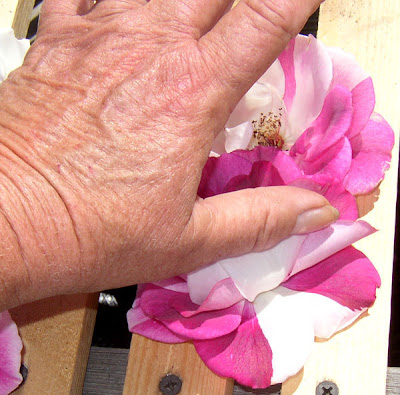
Hollyhocks remind me of my grandmother and when I think old-fashion garden flowers, they're right there with geraniums, phlox, daisies, gladiolas, and petunias. The old-fashion flowers are the perfect companions for roses, my favorite flowers of all. All of these and more are essentially mandatory if you're going for the English cottage garden style. This was my garden style for a decade or so and I delighted in it.
On the downside, the cottage garden is fairly labor intensive. Weeds are the bane of its existence and weeding is strictly a hands and knees operation. When 2 aspirin and a soak in a hot tub could no longer remedy the aches and pains of a lost weekend spent weeding, I found new homes for many of my old-fashion perennials. I ordered a dump truck load of bark, held onto the roses, and planted a select few specimen plants, like the hollyhocks, amongst the roses.

I'm down to a single large bed, a cutting garden, where I pay homage to the annuals and perennials I love. This year, geraniums, phlox, dahlias, alyssum, foxglove, petunias, zinnias and four o'clocks surround a dozen pink Simplicity roses. The weeds persist, but the task of pulling them out by their nasty little roots no longer seems like a mountain too high to climb.

The pink Simplicity roses have been a terrific choice for this bed. Simplicity is a floribunda introduced to the U.S. in 1979 by Jackson & Perkins. Simplicity is aptly named. The double blooms average just 17-25 petals and give the impression of the single bloom species roses in grandma's garden in those halcyon days before hybrid teas. When given plenty of food and water, Simplicity resists disease well. The most endearing quality, perhaps, is its delicate, perfectly formed buds. A little florist's wire and green tape - voila! - the perfect corsage or boutonniere for that special occasion. This rose grows to about 5', but can be pruned back in early spring and mid-summer to keep it from becoming too leggy. I've seen these planted cheek-by-jowl as a hedge rose, too. Absolutely stunning. They last only 3 or 4 days in a bouquet, but a pretty addition nonetheless.

Speaking of daisies...this low-growing variety is fabulous. Too many years have passed since I first planted it, so I can't tell you what name to ask for at your garden center. Unlike the Shasta variety, these are just 24" tall with a mounded growth habit, so they won't fall over at the first sign of wind stronger than a whisper. Best of all, they last more than a week in the vase. If there's anything more cheerful than daisies, I'm not sure what it is. A single plant is all you'll need. They grow rapidly in a single season and are easily divided in the fall or early spring. In a few years time, you'll have all the daisies you've ever wanted.
Here's a few more photos for you to enjoy...

"Rhumba Fire" zonal geranium, "Dreams Rose" petunias, white dwarf dahlias

"Charleston" zonal geranium - unusual coral pink color

"Blues" zonal geranium - variegated pink with pale pink eye next to "Dreams Rose" petunias

Bicolor phlox, bright pink with white star center

Double coral pink hollyhocks amongst the roses
They say that everything old is new again. If you're looking for a new direction for your garden, maybe some of these old garden flowers will fill the bill.
 Isn't that just crazy? I have two branches on this bush producing these harlequin style blooms. Even stranger, some of these blooms have petals with the 1/2 and 1/2 coloring - sometimes bright pink and white, sometimes bright pink and pale pink. Check it out:
Isn't that just crazy? I have two branches on this bush producing these harlequin style blooms. Even stranger, some of these blooms have petals with the 1/2 and 1/2 coloring - sometimes bright pink and white, sometimes bright pink and pale pink. Check it out: Imagine a rose whose blooms were entirely made up of 1/2 and 1/2 petals or one that always produced the half white, half pink blooms like the one at the top left in the photo above. I'd certainly buy a rose like that, wouldn't you?
Imagine a rose whose blooms were entirely made up of 1/2 and 1/2 petals or one that always produced the half white, half pink blooms like the one at the top left in the photo above. I'd certainly buy a rose like that, wouldn't you?











